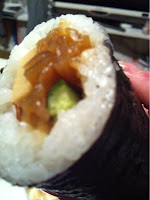Setsubun, also known a Bean Throwing Day, is celebrated on the 3rd of February.
This day is famously celebrated by throwing beans at a demon, oni, to drive him away. This is called mame maki, mame being the beans ( hence eda-mame); however the beans being thrown on this day are roasted soybeans, called fuku-mame (fuku meaning fortune). Typically one poor soul gets to be the oni and people will throw beans at him. This is often the man of the house or occasionally if there is anyone present who is representative of the coming years zodiac sign. The oni gets to wear a special oni mask that can be pricked up for free at the local grocery store, or nicer ones can be purchased elsewhere. Mame-maki is done while saying "Oni wa soto! Fuku wa uchi!" which means to drive the oni out and welcome in happiness. After driving out the demon, you can eat your fortune ( the beans) on the ground...or happily step on them, but eating them is considered luckier.
This whole ritual is done just before Risshun, or the beginning of spring. Thus Setsubun is the separation between winter, and spring. Ideally this day would be considered New Years eve in accordance with the lunar calendar; however as with most holidays in today's Japan, this is now a fixed day of the year and does not always coincide with the lunar New Year ( which was January 23rd this year).
Other ways that this holiday is celebrated is through their food culture. Common dishes on this day are a grilled sardine, of which everything is to be eaten, and a large type of sushi roll called, ehomaki, and of course the roasted soy beans. Ehomaki is a funny little tradition. It contains 7 lucky ingredients ( these tend to vary or be eaters choice) and then is eaten in a particular direction. This direction changes every year. This year it was North NorthWest. You then eat this entire engorged sushi roll without chatter or distraction. You are not really supposed to pause, but that does not mean that you are supposed to choke the whole thing down either. Once accomplished, your luck is now certified. Edo-maki, by most accounts, has originated in Osaka. This being the case, it is largely a kansai tradition. The accounts by which edo-maki seems to have originated tend to vary, some involving geishas or farmers and others stills involve samurai, nevertheless the point remains the same at the end of all these tales. They all obtained their luck from eating this roll.
After your meal opener, the main course is served.
Next the sardine is eaten from head to tail, bones and all. Personally, I could not quite achieve this. This is eaten because it is said that the oni cannot stand the smell of it and will forgo devouring you.
Lastly, after eating all this fun food and chasing my demons away, I went to a huge bonfire.
There are many festivities on this day, most located at large temples. Such festivities could include huge bean throwing events, and concerts, and at Yasaka-jinja, near the Gion district in Kyoto, you will have the fabulous opportunity to see geishas and maikos perform a dance for the gods.
Also in Kyoto, Yoshi-da Temple (吉田神社) is a shrine that hold a massive Setsubun event. They compile a huge sacrifice, arrows, wood plates, bamboo, or anything thing that you wish to sacrifice to bring you luck. These items are then strapped to this massive barrel shaped bamboo structure. At exactly eleven, the pile is set fire ( with many fire fighters on guard). It will continue to burn for quite a while and smolder for longer after. This year the flames got so high the firemen had to chase them down a bit. If you wish to see this make sure you are there half an hour in advance, as the security guards stopped entry just after I arrived. Apparently those beans gave me better fortune than I warranted!







No comments:
Post a Comment